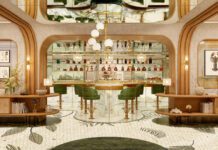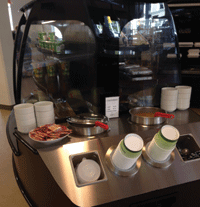From merchandising units to complementary countertop appliances, foodservice operators are giving patrons a new window into the world of food. Gone are the days of the long grocery-style displays stuffed with all manner of sundries. Now operators are combining short, tall, narrow, wide, straight or curved hot-and-cold display systems in a bid to create aesthetic appeal.
There’s a new glamour in hot-and-cold display systems, and it’s trickling down to the restaurant sector, says Sandra Matheson, president of Food Systems Consulting Inc., in Oakville, Ont. “Whether it’s custom work like [the] QDB [brand offers], or [standard] lines like Hatco, people are picking up on the idea of solid surfacing materials [that look like natural stone] and moving away from laminates and stainless steel.”
On the refrigerated side, Matheson reports progress on the mechanics and the aesthetics of display cases. “Condensation used to be a problem in some environments, but better quality glass and air circulation is improving that. Even systems that are similar in style and look function a lot better now, and most display cases have pull-out glass fronts that make them much easier to keep clean. We’re also seeing interesting lighting applications.”
Refrigeration systems have also advanced considerably when it comes to energy-efficiency. “Energy Star hadn’t tackled very much in terms of commercial foodservice until three years ago. The first thing they addressed was refrigeration systems,” says Gary Lummis, president of Lummis & Co., a foodservice facilities consultancy in Fredericton.
Another important aspect of refrigerated systems has been compliance with NSF guidelines for maintaining temperatures for food on display, Lummis adds. “Some municipalities have turned those into code requirements.” The main technology for maintaining temperatures is horizontal air curtains that flow cool air across the top of serving pans. Other advancements include cold wells in which refrigeration coils are wrapped along the walls of the pans as well as the bottom.
For aesthetic appeal, Lummis often turns to Toronto-based QBD displays for cabinetry, but there are many other options. “There’s such a wide range for display cases, including National Refrigeration, Delfield — which is part of the Garland Group — and Hatco, which has recently developed modular drop-in units. Much of the True line is mobile, so units can be rolled in and out; and Vollrath also makes a fairly big line of modular cafeteria serving stations that are self-contained units on wheels.”
Since many people are interested in seeing food prepared in front of them, utensils and ingredients are becoming an integral part of the merchandising picture, too. “We’re seeing a lot more cooking equipment being put into server areas of large cafeterias,” Lummis says. The advent of portable induction systems has played a big part in this evolution. The technology’s versatility is ideal for menu changes throughout the day. And, when it’s not being used to cook in front of customers, the ceramic tops can serve as counters to display items at room temperature.
These days it’s about providing the best customer experience. At Marché Brookfield Place in Toronto, everything is part of the display experience, from the glass partitions and panelling to the stone-inspired countertops, cooking ingredients and appliances. “Customers want to see how dishes are put together and what we use, so we make sure the ingredients are in view. The visual aspect is very important to consumers nowadays. [Dining] has become very tactile for them,” says Georg Shana, director of Operations.
In fact, the Marché self-serve stations have been designed to create a wow-factor, from juices embedded in beds of ice, to the mini greenhouse behind the salad bar for growing organic vegetables. An important aspect of any equipment used at the chain is flexibility. “A lot of counter units are on wheels, so we can move things around,” says Shana.
A big part of the changes to the self-service display arena are due to consumer attitudes, Matheson says. “The whole dynamic is changing from having three meals a day, especially in hospitals and universities. It’s very common [for there to be few peak times] at lunch. Instead there’s a greater need for self-serve satellite facilities where people can grab food on the go without having to walk to larger facilities.”
The team at Red River College in Winnipeg recently invested in a customized refrigerated and heated Oasis display system from Structural Concepts for that very reason. The island-style system holds hot items at the ends, while the centre features adjustable shelving for salad, sandwich and snack items. “Because the area is curved, the design allows for traffic flow around each side. The big plus is that it’s multi-use and very flexible,” says Jeff Gill, director, Foodservices, of the system that he estimates to cost approximately $18,000.
But, ultimately visual appeal is a top priority. At the new Richtree Natural Market at the Toronto Eaton Centre, 11 uniquely branded food stations feature an eclectic collection of displays. “Every space has been thought out to match a theme and create the look and feel of a food court,” explains Shige Hatanaka, SVP of Operations, Richtree Natural Market Restaurants in Irvington, N.Y. Each food station features its own design elements, from diner-or deli-style surfaces
and displays to new Asian- and bistro-style counters and facings. One-sixth of the floor space for the new 20,000-sq.-ft. operation is a dedicated “grocery store” area where elaborate banks of self-serve display units offer a selection of fresh foods, snacks and beverages. It seems fitting given that grocery operations were among the first to move into market-style merchandising. “The influence of stores like Whole Foods on the industry has been pretty dramatic,” says Matheson.





















